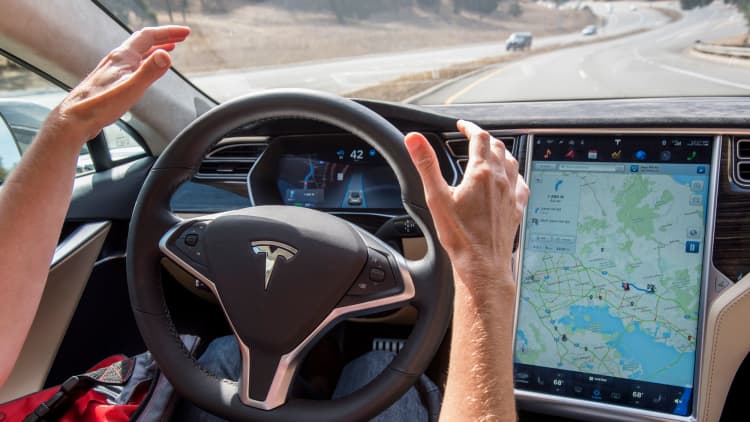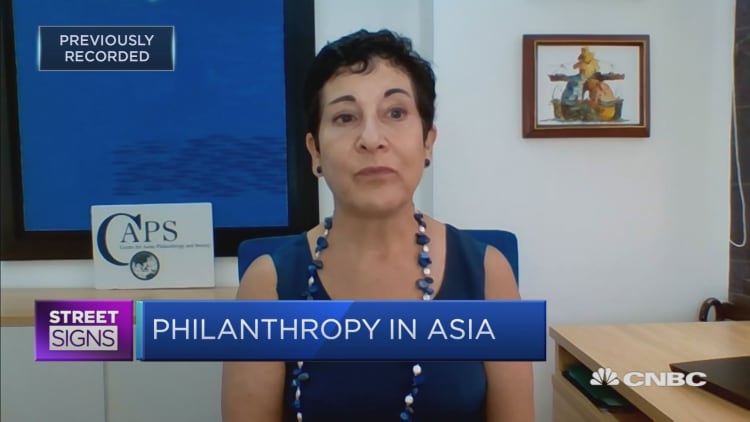
Five years ago, the impact of technology on auto insurers was thought to be straightforward: Self-driving cars were coming soon, and they would be so safe, and people would need car insurance about as much as printed newspapers.
If only it had been so simple.
Instead, technology is coming to cars, and insurance, much more gradually. Insurance companies like Allstate, Progressive, and Berkshire Hathaway's Geico are embracing it, but in a measured way. And the impact on their business seems likely to be slow and steady, rather than rapidly transformative.
Instead of self-driving cars, the auto industry is moving cautiously toward better safety equipment and information sharing. Research into autonomous and more-connected vehicles is helping to make those goals more attainable. And insurers are settling for baby steps like in-car monitors that let customers get discounts if they let carriers track how often they accelerate, swerve or stop suddenly — all behavior tied to accident rates. That means change is coming, but much more slowly, to a once-hidebound business that tech seers thought was next in line to get disrupted.
"A few years ago there was almost an alarmist mindset," said CFRA Research analyst Cathy Seifert. "Then there were high-profile accidents with autonomous vehicles, and naysayers were like, 'I told you so.' Now we're not so much preparing for fully [autonomous personal cars and SUVs]. What I do see coming faster is adoption in corporate or commercial vehicles."
Auto insurance may be the best example in years of the consulting firm Gartner's "hype cycle," an arc where emerging technologies are first overestimated, then fall into a "trough of disillusionment." Over time, the theory goes, companies figure out what the new technology really can do, or not do, and reaches a "plateau of productivity" that reflects its real potential. Right now, driverless cars are in the trough of disillusionment.
Fully self-driving cars may be as much as a decade away. Even if the technology advances sooner, fully or nearly-fully autonomous cars won't take any major market share before 2030, argues consulting firm Counterpoint Research.
What auto insurers are doing with technology
In the meantime, drivers are seeing much more modest changes in their cars. Advances like lane departure warnings and systems that stop cars automatically if they detect pedestrians in their path may, eventually, cut accident rates and insurance claims because lane departures cause about 13,000 deaths in 2015, according to the U.S. Transportation Dept. But this technology was standard equipment on only about 6% of cars in model year 2017. Pedestrian braking systems vary widely in quality, and pedestrian deaths in car crashes hit an 28-year high in 2018.
So what's an insurance company to do? Seifert says the industry is bifurcating into companies that are aggressively adapting to intermediate measures (like Progressive and Allstate), and those like Berkshire Hathaway's Geico that she said have moved more slowly.
"We've always thought of ourselves as a data company,'' said Ginger Purgatorio, senior vice president of product management at Northbrook, Illinois-based Allstate. "We gather information about customers and relay it back to them, traditionally in the form of pricing and more recently in experience. It's just more data about the same risks we always gathered information about.''
For now, insurers are making bets that incremental technologies improve the business — for themselves and their customers — more than transform it.
The prime examples are technologies that let insurers monitor their clients' cars and driving in exchange for discounts on coverage, which Seifert estimates that 20% of new policy holders use. The most popular let insurers see how often their clients are making sudden moves that can lead to accidents, or that may be meant to get drivers out of already-sticky situations. Others, like Allstate's Milewise, monitor simply how many miles the car goes, letting little-used cars qualify for less-expensive policies. Start-ups like Root Insurance, which ranked No. 18 on the 2020 CNBC Disruptor 50 list, are also attempting to upend the industry's approach to evaluating driver risk.

Insurers' advertisements are pushing these programs heavily. It's hard to watch TV these days without seeing the Flo character in Progressive's long-running ad campaign tout its Snapshot app, the oldest such app. Allstate had actress Tina Fey touting its Drivewise app in TV spots featuring Dean Winters as the long-running Mayhem character. State Farm featured Green Bay Packers quarterback Aaron Rodgers as an SUV-driving user of its Drive Safe and Save app refusing to let his hapless sports agent convince him to run a yellow light lest it mess with his discount.
The average customer who installs one of these devices saves about 8%-12% on a policy, Allstate spokesman Justin Herndon says. About a third of new customers, and 15% of customers overall, use either Drivewise or Milewise at Allstate, he added. One irony is that more-connected younger drivers are more apt to embrace the technology, but they save less because they actually are more prone to fast stops and starts, Purgatorio said.
The technologies are less invasive than one might imagine. Many don't have technology commonly available through Waze and other traffic apps that would let insurance companies know the speed limit on every street a car traverses, or where stop signs are. So that State Farm commercial featuring Rodgers at the yellow light is kind of half right. Apps like this can tell if he sped up, as people do to beat red lights, but likely wouldn't know if the light was yellow or green. State Farm's app gives information on five variables: Speed, cornering, phone use, braking and acceleration.
"Braking for one deer won't make or break you,'' Purgatorio said. "If there are a lot of deer where you live, you need to be slowing down anyway."
The future of car accidents
Some of the new technology carmakers have adopted isn't popular enough yet to cut accident rates meaningfully.
That's one reason why auto accidents haven't dropped much, and neither have insurance claims, according to industry data. U.S. auto fatalities dropped for decades beginning around 1980, but fatality rates have actually risen slightly since 2014 as automation-related features made it to market, and total motor vehicle crashes have risen 26% since 2011, according to the Insurance Information Institute, even though cars with the features do have lower accident rates.
"Old vehicles are still going to crash into the new vehicles," said Justin Davis, director of enterprise research at State Farm, referring to the fact that even with the new features, roads are full of vehicles that don't have them, so there will still be in accidents until usage is closer to universal.
Teslas in self-driving mode have been linked to a few fatalities, and the National Transportation Safety Board called out Tesla during a hearing on self-driving in February. A vice chairman for NTSB, Bruce Landsberg, called Tesla's Autosteer "completely inadequate," while NTSB Chair Robert Sumwalt cautioned drivers, "If you own a car with partial automation, do you not own a self-driving car. So don't pretend you do."
What has occurred so far in terms of self-driving tech on the road is a long way from the hype a few years ago. Back then, Barclays analyst Brian Johnson was among the most prominent voices insisting that everything would change very much, and pretty soon. Tesla CEO Elon Musk, in particular, said the automaker's AutoPilot feature would make watching the road, or even owning cars, obsolete for many drivers.
It's almost getting to a point where I can go from my house to work with no interventions despite going through construction and widely varying situations. So this is why I'm very confident about its Full Self-Driving functionality being complete by the end of this year. It's because I'm literally driving it.Elon MuskTesla CEO
Musk is known for issuing forecasts where his ambitions can run ahead of the reality. He once said the "feature complete" self-driving would be ready by the end of 2019; at last April's Tesla investor day he said by mid-2020 Tesla drivers wouldn't have to pay attention to the road. On a call with analysts in January, he said it was maybe a few months away, and that consumers would see progress that was "extremely rapid."
Tesla did not respond to a request for comment, but on this past week's earnings call, the Tesla CEO said the company is continuing to push the envelope on self-driving and the nascent auto insurance business will grow in relation to autopilot technology. Full self-driving software is now tackling intersections, city streets and narrow streets, Musk said on the call. In the past he has described "feature complete" as being able to travel from home to work with no intervention, and that's something that in recent months Musk said he has been on the roads with himself.
"I personally tested the latest Alpha build of the Full Self-Driving software when I drive my car, and it is really, I think, profoundly better than people realize, yes, really profound. It's like amazing," Musk said on the call. "It's almost getting to a point where I can go from my house to work with no interventions despite going through construction and widely varying situations. So this is why I'm very confident about its Full Self-Driving functionality being complete by the end of this year. It's because I'm literally driving it."
Tesla is betting that higher use of Autopilot will lead to reduced insurance costs as well as the probability of injury and, ultimately, make insurance offered directly by Tesla to drivers a major product for the company, including for its planned use of Tesla cars to develop a ride-hail network of robotaxis.
The insurance is available now in California and Tesla officials said the focus is being able to expand in what is a "heavily regulated" market.
Musk has said in the past that California drivers can pay an amount equal to 25%-50% of a lease payment for insurance. "And a lot of that insurance cost is just because the insurance companies don't have good information about the drivers and that there is no good way to provide feedback where it's a very poor feedback mechanism in terms of the insurance rates versus the actual way that the car is being driven, whereas we can do that in real time. It's a fundamental information advantage that insurance companies don't have."
"FSD is just overwhelmingly the most important thing. ... everything else is pretty small by comparison," Musk said on this week's earnings call.
Self-driving skepticism
Many others outside Tesla are less sure about how quickly self-driving will be ready.
"Autos at [January's Consumer Electronics Show] seemed to us to mark a retreat from a vision of mobility centered around autonomous ride-sharing and back to a focus on making the experience of human driving safer, more comfortable, less polluting, more connected and more digital, " Johnson, who was not available for an interview, wrote in an early 2020 report. "Put another way, the focus was around the "C" and the "E" in the ACES framework (Automated, Connected, Electrified and Shared)."
Apps that resemble what we see now will help insurers price risk and even assess accident damage and settle claims more quickly, Seifert said. And venture capital interest in insurance related technology is high. Insurance tech actually raised more money than payments companies for most of the last two years, she said. But insurance startups Root Insurance and MetroMile, which rely on telematics to drive pricing, aren't yet profitable, she said.
Over time, insurers are waiting to see how technology changes transportation before they know its impact on insurance. Products to cover ridesharing vehicles, electric bikes and other emerging transportation forms are likely, State Farm's Davis said.
"We don't assume you have to own a car to have some of these products," he said. "If you use Uber one day and a bike share the next, that's a different risk.''
"Hopefully it will still have an impact on crashes," Davis said. "But it's a little early to know what that will look like.''
Tesla as a 'revolutionary' insurance company
Tesla CFO Zachary Kirkhorn said on the latest earnings call that the current insurance product offered in California is just "version one."
"Where we want to get to with Tesla Insurance is to be able to use the data that's captured in the car, in the driving profile of the person in the car, to be able to assess correlations and probabilities of crash and be able then to assess a premium on a monthly basis for that customer. And what makes this very exciting for us is the amount of data that is available with the customer's permission to use is not available on any other product or any other vehicle in the world."
Kirkhorn said Tesla decided not to replicate the California product in other states, but delay going into additional states so it could put more effort into the telematics, which refers to technology that merges telecommunications and infomatics.
"Where we are now is nearly complete with the risk and cost analysis associated with the first version of the telematics product. We hope to be filing that in a handful of states with regulators very shortly," the Tesla CFO said, adding that depending on regulatory approvals, Tesla insurance could be available in a "handful of states" by the end of the year.
"The heart of being competitive with insurance is what is the accuracy of your information?" Musk said on the call. "Are you forced to assess people statistically looking in the rearview mirror? Or can you assess people individually, looking ahead with smart projections and inform the driver that -- how they may reduce their -- what actions they can take to reduce their insurance. ... 'you're driving too fast. You're on this, that, the other thing.' It's like, if you want to pay more for insurance, you can. But if you want to pay less, then please don't drive so crazy. Then people can make a choice."
One of Musk's more intriguing ideas on the latest earnings call was about insurance coverage leading to new ideas on how to better design cars to reduce the cost of repair jobs.
"It costs like $15,000 or something crazy and like -- and then we can actually adjust the design of the car and adjust how the repair is done to actually have the fundamental cost of solving that problem would be less," he said about the body work that can result from accidents.
Even if insurers remain confident that their world will not change overnight, or even in the next few years, Musk did give them one thing to worry about in the short-term: Tesla poaching some of their top employees. Musk issued a general job offer on the earnings call to insurance actuaries.
"We're building a great -- like a major insurance company. If you're interested in revolutionary insurance, please join Tesla. I would love to have some high-energy actuaries especially. I have great respect for the actuarial profession. Your guys are great at math. Please join Tesla. Especially if you want to change things and you're annoyed by how slow the industry is, this is the place to be. We want revolutionary actuaries."







